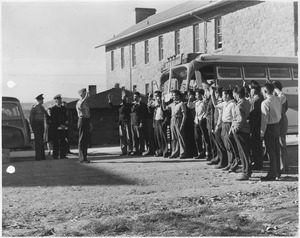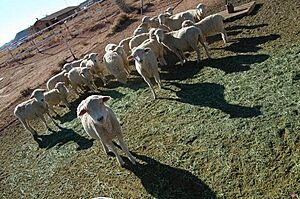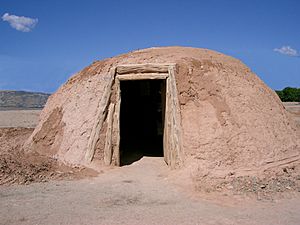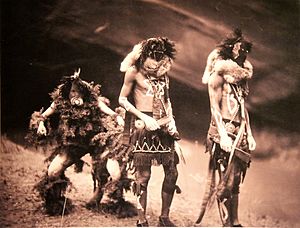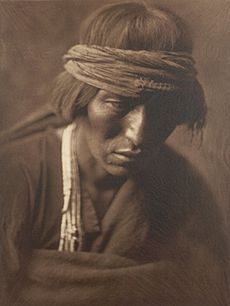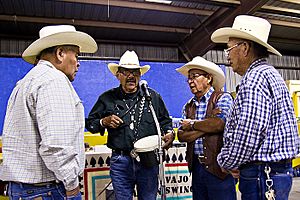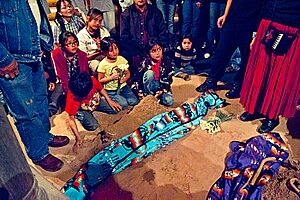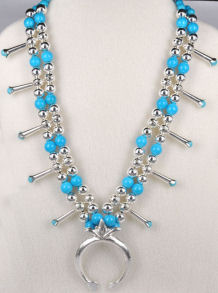Navajo people facts for kids
The Navajo People (who call themselves Diné or Naabeehó) are a large tribe of Native Americans. They live in the southwestern part of the United States. The Navajo tribe has about 300,000 members. This makes them the second largest tribe in the United States.
The Navajo Nation is like an independent government. It runs a very large Native American reservation. This reservation is in parts of Arizona, New Mexico, and Utah. Many Navajo people live there, but not all of them. Most Navajo speak English. Some also speak the Navajo language. The Navajo share many things with the Apache tribe. They might even have common ancestors.
Contents
The Navajo Nation works to manage its own economy. This helps its many members, who number over 250,000. In the 1920s, oil was found on Navajo lands. This discovery helped the tribe start building a proper government. A tribal government was set up in 1923 to handle the oil exploration. Today, the Navajo Nation has the largest and most advanced Native American government. It has become a strong and successful nation on its own.
Navajo code talkers were special Navajo speakers. The U.S. Marines chose them during World War II. They worked in communications units in the Pacific Theater. The Navajo code was created in May 1942. The first 29 Navajo recruits made it.
About 400 Navajos became code talkers. Their training was very difficult. They had to memorize all 17 pages of the code. From 1942 to 1945, Navajo Code Talkers were part of every Marine attack in the Pacific. They served in all six Marine divisions. They also helped parachute units and Marine Raider battalions. They sent messages on the battlefield. These messages included orders, troop movements, and supplies.
The Japanese could break codes used by the United States Army. But they could never break the Marine codes. Even a Navajo soldier captured during the Battle of Bataan could not understand the code for the Japanese. Major Howard Connor was a signal officer at Iwo Jima. He said, "If it weren't for the Navajos, the Marines would never have taken Iwo Jima."
On September 17, 1992, the Navajo code talkers were honored. This happened at the Pentagon in Washington, DC. The honor was delayed for a long time. This was because the Navajo code was secret.
The name "Navajo" came from the Spanish in the late 1700s. It means "Apaches of Navajó." This came from a Tewa word meaning "fields next to a ravine." The Navajos call themselves Diné.
Like other Apachean groups, the Navajos were semi-nomadic for a long time. This means they moved around with the seasons. They had different places to live for their animals, farming, and gathering food. They also traded or went on raiding trips. They traveled long distances as part of their traditional way of life.
The Navajo have a system of clans. This system defines how people are related. It also shows how families connect. The clan system is exogamous. This means people must marry (and date) outside their own clan. This includes the clans of their four grandparents. Clans are linked to areas, but not just one clan uses an area. Clan members can live far apart but still feel a strong bond.
Historically, Navajo society was matrilineal. This means the women's family owned things. They owned animals, homes, and farming areas. When a Navajo man married, he would move to live with his wife. He would live in her home, near her mother's family. Daughters usually received property from their mothers.
Children belong to their mother's clan. They are "born for" their father's clan. The mother's oldest brother plays a big role in her children's lives. As adults, men represent their mother's clan in tribal politics.
A hogan is the traditional Navajo home. It is built as a shelter for either a man or a woman. The Navajo live in the dry Four Corners area. So, the houses were often made of dried mud. Male hogans are square or cone-shaped. They have a clear rectangular entrance. A female hogan is an eight-sided house. Both are made of wood and covered in mud. The door always faces east to welcome the sun. Navajos also have different types of hogans. Some are for living, and some are for ceremonies. Healing ceremonies or the kinaaldá take place inside a hogan. This type of housing is special to the Navajos. Many Navajo families still prefer a strong, log-walled hogan today. However, most Navajo now live in modern homes or apartments in cities.
Navajos who practice their religion see the hogan as sacred. A religious song called "The Blessingway" (hózhǫ́ǫ́jí) tells how the first hogan was built. Coyote built it with help from Beavers. It was a home for First Man, First Woman, and Talking God. The Beaver People gave Coyote logs and instructions. Navajos built hogans in the traditional way until the 1900s. Then, they started making them with six or eight sides. Hogans are still used as homes, especially by older Navajos. They are now often made with modern materials. Some hogans are kept just for ceremonies.
Spiritual Beliefs
Navajo spiritual practice is about bringing balance and harmony back into a person's life. This helps them be healthy. It is based on the idea of Hózhóójí. The Diné believed in two groups of beings: Earth People and Holy People.
The Navajo believe they traveled through three worlds. Then they arrived in this world, the Fourth World or the Glittering World. As Earth People, the Diné must do all they can. They work to keep balance between Mother Earth and humans. The Diné also try to keep a good relationship with the Diyin Diné (Holy People).
In the Diné Bahane' (Navajo creation stories), the First World was dark. The four Diyin Diné lived there. First Woman and First Man came to be there. But life could not grow well in the dark world. So, they had to move. The Second World was blue. Some animals we know today lived there, as well as the Swallow Chief. The beings from the First World had upset him, so they were asked to leave. From there, they went south to the Third World, which was yellow. The four sacred mountains were found here. But a big flood forced First Woman, First Man, and the Holy People to find another world. This time, when they arrived, they stayed in the Fourth World. In the Glittering World, true death began. Also, the seasons, moon, stars, and sun were created.
The Holy People, or Diyin Diné, told the Earth People to see the four sacred mountains as their homeland's borders. This homeland is called Dinétah. They should never leave it. These mountains are:
- Blanca Peak (Sisnaajiní — Dawn or White Shell Mountain) in Colorado.
- Mount Taylor (Tsoodził — Blue Bead or Turquoise Mountain) in New Mexico.
- The San Francisco Peaks (Dookʼoʼoosłííd — Abalone Shell Mountain) in Arizona.
- Hesperus Mountain (Dibé Nitsaa — Big Mountain Sheep) in Colorado.
Times of day and colors represent these four sacred mountains. The number four is very important in the Navajo religion. For example, there were four original Diné clans. There are four colors and times of day. There are four Diyin Diné. And usually, four songs are sung for a ritual.
Navajos have many different ceremonies. Most of them are to prevent or cure illnesses. Corn pollen is used for blessings and prayers. One main part of Navajo song ceremonial complex is the Blessing Way (Hózhǫ́ǫ́jí). The other part is the Enemy Way (Anaʼí Ndááʼ). Blessing Way ceremonies focus on bringing "peace, harmony, and good things" to the Diné. Enemy Way ceremonies deal with bad influences from outside the Diné. Spiritual healing ceremonies come from Navajo traditional stories. One, the Night Chant ceremony, lasts several days. It involves up to 24 dancers. The dancers wear buckskin masks, like in many other Navajo ceremonies. These masks represent specific gods. The Night Chant aims to purify patients and heal them through prayers. Each day of the ceremony has certain rites and detailed sand paintings. One song describes the home of the thunderbirds:
In Tsegihi [White House],
In the house made of the dawn,
In the house made of the evening light
The ceremony leader asks the Holy People to be present. Then, the patient is linked to the spirit-being's power. The patient's healing is described with lines like, "Happily I recover."
Ceremonies are also used to fix curses that cause sickness or bad luck. People might talk about witches who harm others. But these topics are rarely discussed in detail with people outside the community.
Navajo music is music made by Navajos. It mostly comes from the Four Corners region. This is in the Southwestern United States. It also comes from the Navajo Nation territory. Traditional Navajo music includes ceremonial chants. These often echo themes from Diné Bahaneʼ. Modern Navajo music has many styles. These include country, rock, and rap. Songs are sung in both English and Navajo.
Traditional Music
Traditional Navajo music is always vocal. Most instruments are used to go with singing. These include drums, drumsticks, rattles, rasp, flute, whistle, and bullroarer. In 1982, there were over 1,000 Hataałii, or Singers. These are also called 'Medicine People'. They were trained to perform many ceremonies and prayer rituals. These rituals help bring back hózhǫ́. This word means 'harmonious condition' and 'beauty', good health, peace, and balance.
These sacred songs are very important. They are the "complex and complete" spiritual stories of the Navajo. They can be seen as classical music. Other songs are less sacred. These include personal, patriotic, work, fun, and less sacred ceremonial songs. These can be seen as popular music. The "popular" songs are performed in public. The holy songs are kept sacred. They are only used for ceremonies.
The longest ceremonies can last up to ten days and nights. They perform rituals to bring back balance. This is balance between good and evil, or positive and negative forces. The hataałii (singers) are helped by sandpaintings or masked yéʼii bicheii. They also use other sacred tools for healing. They chant sacred songs to call on Navajo gods and nature. This helps bring the person back to harmony and balance. In ceremonies with sandpaintings, the person being helped sits on the sandpainting. They become part of the Diné Creation Stories.
The lyrics of these songs can last over an hour. They are usually sung in groups. They tell long epic stories. These include the beginning of the world, how things work, morality, and other lessons. Longer songs are split into two or four balanced parts. They have chant-like verses and lively melodically active choruses. They end with a chorus-style refrain. The lyrics often repeat themes. For example, Changing Woman is an immortal figure. She is born in spring, grows up in summer, becomes an adult in autumn, and an old lady in winter. She repeats these life cycles. Her sons, the Hero Twins, Monster Slayer and Born-for-the-Water, are also sung about. They got rid of giants and evil monsters. These stories are told during sacred ceremonies.
The "popular" music has lively melodic motion. It has wide leaps and a melodic range of one to one and a half octaves. The songs are made from repeating, dividing, and combining phrases. Usually, there are no more than four or five phrases. Short songs often follow each other for continuity, like in work songs. Their lyrics are mostly vocables (sounds without specific meaning). Some vocables are specific to certain genres. But they can also have short funny or satirical texts.
Shoegame Songs
Long ago, the animals on Earth played Késhjééʼ, the Navajo moccasin game. Yéʼiitsoh (Giant) and Owl decided to create the Navajo Shoegame. There is a story that goes with this game. It is only told orally by a Diné person.
Today, many families across the Navajo Nation play the Navajo Shoegame. Sometimes, local communities play against each other in winter. There are also many famous Navajo Shoegame singers. The Nez Family from Hunter's Point, Arizona and Pinedale, New Mexico, are well known for their singing and playing. Leo Nez Sr. and his son Titus Jay Nez are very famous for singing Shoegame songs. They also attend many Shoegames. Other notable singers include Jimmy Cody and Sammie Largo.
Children's Songs
Navajo children's songs are usually about animals. These can be pets or farm animals. Some songs are about family members. Others are about chores, games, and other daily activities. They include anything in a child's everyday life. A child might learn songs from their mother from a young age. If a baby cries, the mother will sing to it while it's in a cradleboard. Navajo songs have a rhythm, which is calming for a baby. So, songs are a big part of Navajo culture.
These songs might have been a first step. They helped children learn songs and prayers for protection. This protection was from bad things, like skinwalkers and other evil figures. Blessings, like using corn pollen in the morning, might also be learned.
In children's songs, a short chant usually starts the song. Then comes at least one verse of lyrics. The song finishes with the same chant. All traditional songs include chants. They are not just lyrics. Some types of songs have specific chants. However, modern children's songs, like Christmas songs or Navajo nursery rhymes, might only have lyrics. Today, both types of songs are taught in elementary schools on the reservation. This depends on the teacher's knowledge.
In older times, Navajo children might have sung these songs to themselves. They would sing while herding sheep to pass the time. Sheep were, and still are, a part of Navajo life. Giving a child care of the whole herd taught them leadership and responsibility. One day, they would likely own their own herd. A child, with time on their hands while sheep grazed, might sing to pass the time.
Silverwork
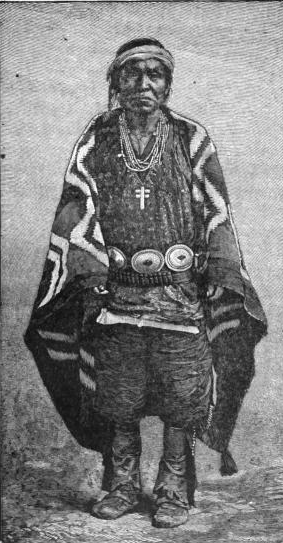
Silversmithing is an important art form for Navajos. Atsidi Sani (born around 1830, died around 1918) is thought to be the first Navajo silversmith. He learned from a Mexican man named Nakai Tsosi around 1878. He then started teaching other Navajos how to work with silver. By 1880, Navajo silversmiths were making handmade jewelry. This included bracelets, tobacco flasks, necklaces, and bracers. Later, they added silver earrings, buckles, bolos, hair ornaments, pins, and squash blossom necklaces. They made these for their own use and to sell to tourists. This helped them earn more money.
The Navajo's special jewelry piece is the "squash blossom" necklace. It first appeared in the 1880s. The name "squash blossom" was given early on. But its bud-shaped beads likely came from Spanish-Mexican pomegranate designs. Navajo silversmiths also used the "naja" (najahe in Navajo) symbol. This is the silver pendant that hangs from the "squash blossom" necklace.
Turquoise has been used in jewelry for centuries. But Navajo artists did not put turquoise into silver designs until the late 1800s.
Weaving
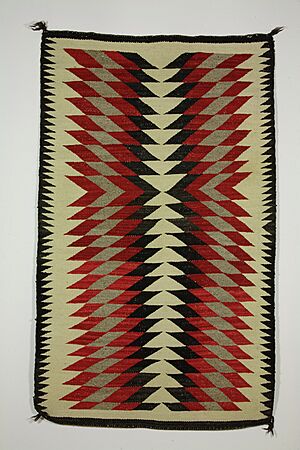
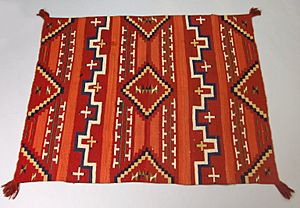
Navajos came to the southwest with their own weaving traditions. However, they learned to weave cotton on upright looms from Pueblo peoples. The first Spaniards to visit the area wrote about seeing Navajo blankets. By the 1700s, Navajos started to buy Bayeta red yarn. This added to their local black, gray, and white wool. They also used wool dyed with indigo. Using an upright loom, Navajos made very fine blankets for everyday use. These blankets were collected by Ute and Plains Indians. These were called Chief's Blankets. Only chiefs or very rich people could afford them. They had horizontal stripes and few red patterns. First Phase Chief's Blankets had only horizontal stripes. Second Phase had red rectangular designs. Third Phase had red diamonds and partial diamond patterns.
The arrival of railroads greatly changed Navajo weaving. Cheap blankets were brought in. So, Navajo weavers started making rugs for people who were not Native. Rail service also brought Germantown wool from Philadelphia. This wool was already dyed. It gave weavers many more colors to use.
Some early European-American settlers moved in. They set up trading posts. They often bought Navajo rugs by weight. Then they sold them back east. The traders encouraged local weavers to make blankets and rugs in special styles. These included:
- "Two Gray Hills" (mostly black and white, with traditional patterns).
- Teec Nos Pos (colorful, with very detailed patterns).
- "Ganado" (started by Don Lorenzo Hubbell), with red patterns and black and white.
- "Crystal" (started by J. B. Moore).
- Oriental and Persian styles (almost always with natural dyes).
- "Wide Ruins", "Chinlee", with banded geometric patterns.
- "Klagetoh", with diamond-type patterns.
- "Red Mesa" and bold diamond patterns.
Many of these patterns show a fourfold symmetry. This is thought to represent traditional ideas about harmony or hózhǫ́.

- Fred Begay, a nuclear physicist and a Korean War veteran.
- Notah Begay III, a professional golfer.
- Klee Benally, a musician and filmmaker.
- Jacoby Ellsbury, a retired baseball player for the New York Yankees.
- Rickie Fowler, a professional golfer.
- Joe Kieyoomia, a soldier captured by the Japanese in 1942.
- Nicco Montaño, a former UFC champion in women's flyweight.
- Chester Nez, the last original Navajo code talker from World War II.
- Krystal Tsosie, a geneticist who works to protect Indigenous data.
- Cory Witherill, the first full-blooded Native American in NASCAR.
- Aaron Yazzie, a mechanical engineer at NASA's Jet Propulsion Laboratory.
Artists
- Beatien Yazz (1928–2022), a painter.
- Apie Begay (active 1902), the first Navajo artist to use European drawing materials.
- Harrison Begay (1914–2012), a Studio painter.
- Joyce Begay-Foss, a weaver, educator, and museum curator.
- Mary Holiday Black (born around 1934, died 2022), a basket maker.
- Nanibah Chacon (born 1980), a painter.
- Raven Chacon (born 1977), a conceptual artist.
- Lorenzo Clayton (born 1940), an artist.
- Carl Nelson Gorman (1907–1998), a painter, printmaker, illustrator, and Navajo code talker.
- R. C. Gorman (1932–2005), a painter and printmaker.
- Hastiin Klah (1867–1937), a weaver and co-founder of a museum.
- David Johns (born 1948), a painter.
- Yazzie Johnson (born 1946), a modern silversmith.
- Betty Manygoats (born 1945), a modern ceramicist.
- Christine Nofchissey McHorse (1948-2021), a ceramicist.
- Gerald Nailor, Sr. (1917–1952), a studio painter.
- Barbara Teller Ornelas (born 1954), a master Navajo weaver and cultural ambassador.
- Atsidi Sani (born around 1828, died 1918), the first known Navajo silversmith.
- Marilou Schultz (born 1954), a textile artist and math teacher.
- Clara Nezbah Sherman (1914–2010), a weaver.
- Ryan Singer (born 1973), a painter, illustrator, and screen printer.
- Tommy Singer (1940–2014), a silversmith and jeweler.
- Quincy Tahoma (1920–1956), a studio painter.
- Tyrrell Tapaha, a modern weaver and printmaker.
- Klah Tso (mid-19th century — early 20th century), a pioneering easel painter.
- Emmi Whitehorse (born 1957), a modern painter.
- Melanie Yazzie (born 1966), a modern printmaker and educator.
- Teresa Montoya, a filmmaker.
Performers
- Jeremiah Bitsui, an actor.
- Blackfire, a punk/alternative rock band.
- Raven Chacon, a composer.
- Radmilla Cody, a traditional singer.
- James and Ernie, a comedy duo.
- Carmen Moore, an actress.
- R. Carlos Nakai, a musician.
- Jock Soto, a ballet dancer.
Politicians
- Chris Deschene, a veteran, lawyer, and community leader.
- Henry Chee Dodge, the last head chief and first chairman of the Navajo Tribe.
- Annie Dodge Wauneka, a former Navajo Tribal Councilwoman and advocate.
- Thomas Dodge, a former chairman of the Navajo Tribe and the first Diné attorney.
- Albert Hale, a former president of the Navajo Nation.
- Christina Haswood, a member of the Kansas House of Representatives.
- Peter MacDonald, a Navajo Code Talker and former chairman of the Navajo Tribe.
- Mark Maryboy, a former Navajo Nation Council Delegate.
- Lilakai Julian Neil, the first woman elected to Navajo Tribal Council.
- Jonathan Nez, a former president of the Navajo Nation.
- Buu Nygren, the current president of the Navajo Nation.
- Ben Shelly, a former president of the Navajo Nation.
- Joe Shirley, Jr., a former president of the Navajo Nation.
- Chris Stearns, a member of the Washington House of Representatives.
- Peterson Zah, the first president of the Navajo Nation and last chairman of the Navajo Tribe.
Writers
- Freddie Bitsoie, an author and chef.
- Sherwin Bitsui, an author and poet.
- Luci Tapahonso, a poet and lecturer.
- Elizabeth Woody, an author, educator, and environmentalist.
Images for kids
-
Navajo cowboy in Monument Valley
-
Untitled. Ansel Adams. 1941. Taken near Canyon de Chelly
-
Jacoby Ellsbury, pictured in a Boston Red Sox uniform, is a Navajo (from his mother's side) baseball player for the New York Yankees.
-
James and Ernie, a Navajo comedy duo and actors
See also
 In Spanish: Navajo para niños
In Spanish: Navajo para niños


